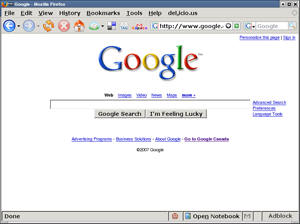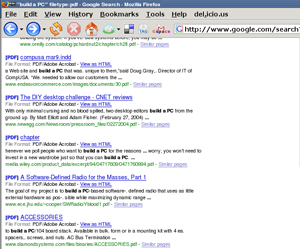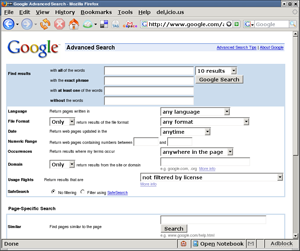|
Tech Tip # 113 - Improving Your Google Searches |
While Google is a great search engine, you've probably noticed that when you do a search, Google usually returns more results that you can comfortably chew. But how can you limit Google's search results?
 Many people know the trick of enclosing a search query in quotes, and some may know about putting a plus sign (+) in front of a search term. But, there's more that you can do. There are a number of really simple techniques for improving your Google searches so that the results better focus on the information that you want. Many people know the trick of enclosing a search query in quotes, and some may know about putting a plus sign (+) in front of a search term. But, there's more that you can do. There are a number of really simple techniques for improving your Google searches so that the results better focus on the information that you want.
|
Using Booleans
Booleans are simply expression that Google (or a text processor) expects to be either true or false. When performing a Google search, booleans can be your friend.
Every time you do a search, Google assumes that you want to find all of the words or terms in your query. For example, typing tips Linux “Windows Vista” is the same as typing the Boolean tips AND Linux AND “Windows Vista”. Google will search for Web sites that contain any combination of the words tips, Linux, and Windows Vista.
But what if you only want to find sites containing tips for Linux or tips for Windows Vista? Just type tips OR Linux OR “Windows Vista”. You can further focus the search by surrounding some of the options in parentheses. So, typing tips (Linux OR “Windows Vista”) is the same as typing tips AND Linux or tips AND “Windows Vista”. |
Searching Files
The language of the Web is HTML. A Web page is just a text file that contains formatting which tells a Web browser how to display the elements on a page.
But people don't just post HTML pages to the Web. They also post Word documents, spreadsheets, slides, and PDFs. Often, these files are packed with information that you won't find anywhere else on the Web. You can get Google to zoom in on those files using the filetype: command. Google can actually search within the contents of the following file types:
- doc (Word documents)
- xls (Excel spreadsheets)
- ppt (PowerPoint presentations)
- pdf (PDF files)
- odt (OpenDocument files)
- ps (Postscript files)
- rtf (Rich Text File documents)
- sfw (Flash multimedia files)
- txt (plain text file
You can also use Google to search such older or seldom-used formats as Lotus 1-2-3 spreadsheets, Microsoft Words files, and MacWrite documents.
 So, if you want to search for information on building a PC from scratch that may reside in a PDF file somewhere on the Web, type “build a PC” filetype:pdf in the Google search box. You can either download the documents that the search returns, or click the View as HTML link beside a result to view the document in your browser. So, if you want to search for information on building a PC from scratch that may reside in a PDF file somewhere on the Web, type “build a PC” filetype:pdf in the Google search box. You can either download the documents that the search returns, or click the View as HTML link beside a result to view the document in your browser.
|
Using Advanced Search

Advanced Search gives you a number of options that allow you to quickly and easily filter your searches by simply pointing and clicking. You get to the Advanced Search page by clicking the link beside the search box on the Google home page.
On the Advanced Search page, you can do the following:
- Select the language for your search
- Specify the type of file to search
- Tell Google that you want to look for all of the words in your query, a specific phrase, at least one word in a query, or to exclude words from a search
There are a number of other options, too.
Advanced Search is quick and easy to use, and it beats having to remember a bunch of Google commands. |
Other Useful Search Techniques
You can further narrow your searches and eliminate a number of irrelevant search results by using the intitle: and intext: commands.
intitle: only looks for text that's in the title of a Web page. In this case, title doesn't mean the title on a page. It's the text between the <title></title> tags in the HTML code of a Web page. This is the text that appears in the title bar of your browser.

So, to find information about hacking your iPod, you can type intitle:”iPod hack” in the Google search box.
On the other hand, intext: searches the body of the Web page for the text that you want to find. When you specify intext:, Google ignores the text in any links or email addresses on the page, as well as the text in the page's title. Going back to the iPod hacks search, you'd type intext:”iPod hack” in the Google search box.
 What if you only want to find out what a word or term means? Just use the define: command followed by the word or term. Say, during your reading on the Web, you run into a page that uses the word Boolean. Just type define: Boolean in the Google search box. If all goes well, you'll get one or more definitions from around the Web. What if you only want to find out what a word or term means? Just use the define: command followed by the word or term. Say, during your reading on the Web, you run into a page that uses the word Boolean. Just type define: Boolean in the Google search box. If all goes well, you'll get one or more definitions from around the Web.
Keep in mind that this doesn't always work, though – Google sometimes can't find a definition.
|
For More Information
The techniques discussed in this TechTip only scratch the surface of Google's capabilities. You can find more information about advanced Google search techniques at the Google Web site, or the Google Guide Web site (a fantastic collection of Google tips). Another great source of information is the book Google Pocket Guide. This 140 page book is light enough to carry anywhere, but is packed with a number of useful tips and tricks.
Once you get the hang of the advanced techniques available to you, Google will definitely open a whole new world of Web searching to you.
|
On a more serious note:
If you go to the website LetsSayThanks.com you can pick out a thank you card that Xerox will print and send to a soldier that is currently serving in Iraq. You can't choose who gets it, but it will go to a member of the U.S. armed services. How AMAZING it would be if we could get everyone we know to send one!
| |
Disclaimer: Occasionally we miss something, make a mistake, or don't cover everything on the topic but we are trying hard to give you the most unbiased and well-written information that we can. |
|
|
| Tips provided with the help of geeks.com |
|
| |
|
| Yorkville PC Services |
|
|
 |
On-Site Computer Repair
Preventative Maintenance
|
| Wireless Networks |
| Internet Security |
| Virus / Spyware Removal |
| Data Backup & Recovery |
Custom PC's
Upgrades & Parts |
|
|
|
|
Special Offers:


|
|
|
YPC QUICK TIPS!
5 Steps To Keep Your PC Safe Online |
There are some simple steps you can take to ensure your PC remains protected while you surf the Web. Following these tips can help protect your PC from virus, spyware and other online threats.
1. Update Windows
Microsoft regularly releases free downloads to fix security problems with Windows, Internet Explorer and other Microsoft software such as Office. Visit Windows Update and Office Update regularly.
2. Install A Firewall
A good firewall such as Zone Alarm will prevent programs from accessing the Internet without your permission, and block access to your PC from intruders.
3. Check For Viruses
Malicious virus code can infect your PC’s system files and damage your important data. Read Check For Viruses which explains how to use an anti-virus program to find and remove malicious programs.
4. Remove Spyware
Spyware is malicious code that tracks your movements on the Internet and can even affect your PC's performance. If your computer is running slow or if your having trouble with pop up advertisements, call Yorkville PC for help!
5. Browse More Safely
The latest web browsers such as Internet Explorer 7 and Firefox 2 offer security features like pop-up blockers and phishing filters to keep you safe when visiting web sites. |
|
|